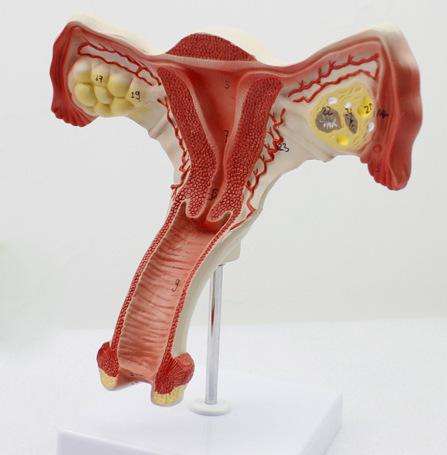female reproductive physiology
1. Mons pubis.
It is the raised part of the vulva in front of the symphysis pubis, composed of skin and a thick layer of fat. Pubic hair begins to grow on the skin during puberty, and the distribution is a downward-pointing triangle.
2. The labia majora.
It is a pair of oblong raised skin folds on both sides of the vulva, near the inner sides of the two strands. The front is connected to the mons pubis, and the back is connected to the perineum; from the mons pubis, it stretches downward and backward, and the left and right labia majora in front combine to become the anterior joint, and the two ends at the back merge into the posterior joint. The posterior joint is located in front of the anus, but it is not as good as the anterior joint. obvious. Pubic hair grows on the outside of the labia majora. Subcutaneous adipose tissue, elastic fibers and venous plexus are prone to hematoma after injury. The labia majora on both sides of unmarried women are naturally closed to cover the vaginal opening and urethral opening. The labia majora of a multiparous woman are separated on both sides due to the effects of childbirth.
3. The labia minora.
It is a pair of mucosal folds that are moist on the inner side of the labia majora. The upper bifurcations of the left and right sides of the labia minora are combined with each other, the upper skinfold is called the clitoral foreskin, the lower skinfold is called the clitoral frenulum, and the clitoris is in the middle of them. The lower ends of the labia minora meet under the vaginal opening and are called the labia frenulum. There are abundant nerve distribution under the mucosa of labia minora, so the feeling is sensitive.
4. The clitoris.
Located at the top between the labia minora on both sides, it is a small oblong organ with a round head at the end and a thin bundle of erectile tissue at the inner end. Erectile tissue is cavernous tissue, rich in venous plexus, and rich in nerve endings, so it feels sharp and easy to bleed after injury. A woman's clitoris is equivalent to the glans of a man's penis.
female reproductive physiology
5, vestibule.
The prismatic area surrounded by the labia minora on both sides is called the vestibule. The surface is covered by mucous membranes, which is similar to a triangle, the tip of the triangle is the clitoris, the bottom is the labia frenulum, and the two sides are the labia minora. The opening of the urethra is in the upper vestibule. The vaginal opening is in its lower part. Also in this area are the bulb of the vestibule and the bartholin gland.
The vaginal opening is covered by an incompletely closed mucous membrane called the hymen. There is a hole in the middle of the hymen, from which the menstrual blood flows. The size of the hymen hole and the thickness of the membrane vary from person to person. After the hymen is ruptured, the mucous membrane appears as many small spherical objects, which become hymen scars. The hymen doesn't say anything.
6, vestibular ball.
Department of a pair of cavernous tissue, also known as bulbs cavernosa, with erection. located on both sides of the vaginal opening. It is connected to the clitoral vein in the front, and the Bartholin gland behind, and the surface is covered by the bulbocavernosus muscle. Bleeding easily after injury.
7, the urethra.
Between the lower border of the pubic symphysis and the vaginal opening, there is an irregular oval hole through which urine flows out. Its posterior wall has a pair of glands, called paraurethral glands, which open in the posterior wall of the urethra and are often where bacteria lurk.
8, Bartholin's gland, also known as Bartholin's gland.
Located at the lower end of the vagina, behind the labia majora, it is also covered by the bulbocavernosus muscle. It is a gland the size of a small broad bean on one side. Its glandular duct is very narrow, about 1.5 to 2 cm, and opens on the inner side of the lower end of the labia minora. The epidermis of the glandular duct is mostly squamous epithelium, and only the innermost end of the tube is composed of a layer of columnar cells. When sexually excited, it secretes yellow-white mucus to lubricate the vaginal opening. This gland cannot be touched during normal examination









